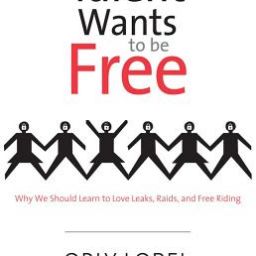This is the abstract and a short conclusion from my recent AALS presentation; the article will be published in IDEA: The Intellectual Property Law Review. Also, for a longer version, read Rebecca Tushnet’s writeup of my presentation of an earlier draft at the 2009 IP Works in Progress conference.
Academics are involved in an unique circular relationship to intellectual property. They build their work “on the shoulder of giants” – building on the expression of ideas by others, often being paid for work relating to their production of copyrighted materials, yet the custom is for them to retain copyright.
Academics then gift, sell, or license their works to publishers, who then sell or license these works back to the institutions that were the underlying support for their creation. This leads to several unfortunate situations: institutions paying for work twice, academics holding the inaccurate viewpoint that they can use copyrighted materials as long as they are for educational purposes, and academics technically being unable to reuse or revise works once their copyright has been transferred.
Further complicating the situation is language in the licenses for many of the databases that academics use – explicitly rejecting use for non-educational purposes or commercial purposes.
My forthcoming article discusses the development of the teacher exception to copyright through both common practice and case law, but will focus primarily on the potential solutions:
- contract: explicitly changing the contract terms of employment;
- statutory interpretation: by interpreting fair use broadly to more explicitly include educational use by the institution that pays for the work’s creation;
- statute: creating an exception to copyright similar to public access to government funded research by the National Institutes of Health (42 USC § 282c (2009)); and
- license: creating an open access / institutional repository to create an access point for faculty research, similar to the new policy followed by the Faculty of Arts and Sciences of Harvard University.
My Solution
A Multifaceted Institutional Repository to suit the needs of institutions and faculty:
- To include all published academic works produced through institutional funding
- Allows for portability for faculty from institution to institution
- Will have buy-in from all levels – prefer mandate approved by faculty
- Will allow for other faculty at the funding institution to use without needing to be concerned about permissions
- Use present open source searching and later searching improvements
- Allow for additions to the repository to be made by
- Author, publisher, or institution (such as through the library)
- Would allow for a delay (as with NIH mandate of placement in repository within 12 months)
Want more? Including why law review publishing is an ideal place to start creating an effective cross-? Then you’ll need to wait for the article!



Interesting subject. What would it be like if we did not expect payment for that which we think and publish and that we did not retain ownership over intellectual property and simply shared our intellecual property for the sake of all mankind? Imagine – as John Lennon would ask us to do.